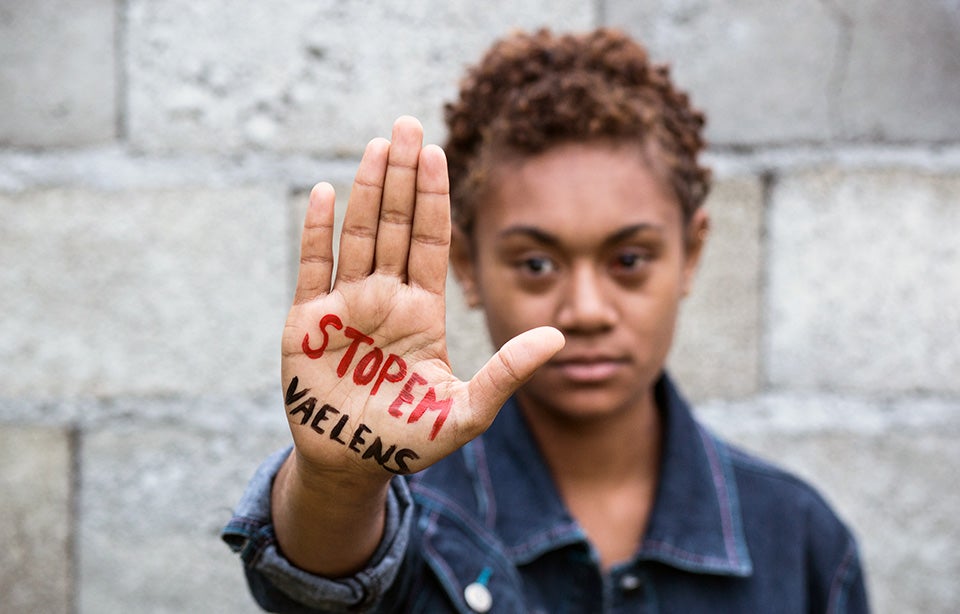Phase II: 2024-2027
Phase II of the Pacific Partnership builds on the achievements of Phase I and of the Spotlight Initiative Pacific Regional Programme (2019-2023), which are comprehensive, multi-faceted programmes, grounded in an aligned theory of change. The programme is informed by the lessons and key recommendations of the Pacific Partnership Phase I Mid-Term Evaluation and the Spotlight Initiative Mid-Term Assessment. It expands on Phase I results and wide-ranging regional and national partnerships. It will complement and ensure harmonisation with other gender equality programmes in the region, including the Government of Australia’s Pacific Women’s Lead programme, and other major initiatives on gender equality and ending violence against women and girls.
In Phase II of the programme from 2024-2027, the USD 19.15 million partnership is funded primarily by the Government of Australia (USD 10.7m), and the European Union (USD 8.2m), and coordinated by UN Women and the Pacific Community (SPC), in strategic partnership with the Pacific Islands Forum (PIF).
The overall objective of the programme is to promote gender equality and prevent violence against women and girls in the PICTs. Elements of the programme will be delivered over four years in target PICTs, including Fiji, Kiribati, Palau, Republic of the Marshall Islands, Samoa, Solomon Islands, Tonga, Tuvalu, and Vanuatu, through activities that contribute to four key outcomes:
During Pacific Partnership Phase I, Service Delivery Protocols (SDPs) in five Pacific countries were developed and implemented, which established a coordinated, multisector framework for survivor-focused services. The introduction of multisector coordination bodies like SAFENET in Solomon Islands and SafeNet in Kiribati significantly increased referrals across police, health, crisis centers, and social services, demonstrating the effectiveness of improved coordination. The programme worked with institutions not traditionally involved in ending violence against women and girls’ efforts, such as schools, churches, and sports organisations. This helped in gradually shifting social norms and increasing empowerment among women and girls within these institutions. The first ever comprehensive whole of government National Action Plans to Prevent Violence Against All Women and Girls was passed in Fiji (2023) and Samoa (2024). Additionally, the programme strengthened civil society by enhancing the capacity and influence of women-led organisations and movements in advocacy and service provision. Over 140 knowledge products were developed, contributing valuable research, policy guidelines, and training materials that have informed both local and global practices in combating violence against women and girls.
On the areas of ongoing work in the Programme:
Building on Phase I of the Pacific Partnership, in Phase II, UN Women and SPC will focus on strengthening the evidence base on what works to prevent VAWG through engaging faith, sports and education, as well as strengthening national systems for coordinated, multisector gender-based violence (GBV) response systems. Phase II will further invest in research on the links between EVAWG and climate change, and support initiatives that provide evidence to decision-makers in support of policy and legislative actions that respond to climate change and environmental protection as a strategy to address VAWG.
Programme Strategy for Phase II
IMPACT: Women and girls in the Pacific will experience a substantial reduction in violence against them, as violence is being prevented before it happens or re-occurs, and those experiencing violence are empowered to recover, strengthen their resilience, and rebuild their lives with appropriate assistance and support.
OUTCOME 1: Regional and national political leadership ensures EVAWG legislation and policies are in line with international standards and translated into implementation and action.
OUTPUTS:
- EVAWG laws and policies are consistently reviewed, resourced, and enforced to meet international human rights standards, driving institutional change.
- Key institutions and governments are equipped to mobilise resources and implement comprehensive National VAWG Prevention Action Plans and policies across sectors such as education, faith, and sports.
OUTCOME 2: Favourable social norms, attitudes and behaviours are promoted at the family, community, and societal levels to prevent VAWG.
OUTPUTS:
- Innovative community mobilisation strategies involving faith, sports, and traditional entities are implemented to change social norms through key influencers.
- Social Citizenship Education curricula and whole-of-school initiatives promoting human rights, gender equality, and non-violent communication are expanded.
- A regional Pacific VAWG Prevention Hub is established to facilitate evidence generation, capacity building, and learning on effective VAWG prevention methods.
OUTCOME 3: Women, girls and children who experience violence (including before, during and after emergencies), have access to coordinated and high quality, essential services (health, police and justice, social services) to recover from violence and perpetrators are held to account.
OUTPUTS:
- Service providers in health, police, justice, and social services have enhanced capacity and budgets to deliver coordinated, timely, and quality services, ensuring accountability for perpetrators and ethical data use.
- Women and girls, particularly in rural areas and those with disabilities or diverse identities, have increased awareness and skills to access these services.
- Disaster management and emergency response systems are better equipped to address safety concerns and reduce violence risks for women and girls during emergencies.
OUTCOME 4: Women’s rights groups, autonomous social movements and relevant CSOs, including those representing youth and groups facing multiple and intersecting forms of discrimination/marginalisation, influence and advance progress on gender equality, women’s empowerment and EVAWG.
OUTPUTS:
- Women’s rights organisations, feminist movements, and civil society networks receive support to advocate for accountability and transformative action against VAWG at regional and global levels.
- Women’s rights organisations, feminist movements and civil society networks have increased opportunities to share knowledge, network, and strengthen coalitions through the use of technology.
The Pacific Partnership recognises the importance of gender equality for achieving sustainable development and directly contributes to the achievement of the Sustainable Development Goals (SDGs), particularly SDG 5 to ‘achieve gender equality and empower all women and girls’, of the 2030 Agenda for Sustainable Development. The programme directly supports the implementation of the Pacific Leaders Gender Equality Declaration 2012 and the Revitalised Pacific Leaders Gender Equality Declaration 2023, the Pacific Roadmap for Sustainable Development, and the Pacific Platform for Action (PPA) on Advancement of Women and Gender Equality.

![[partner's logos]](/sites/default/files/2025-03/fj-Logos-evaw-960px.jpg)
